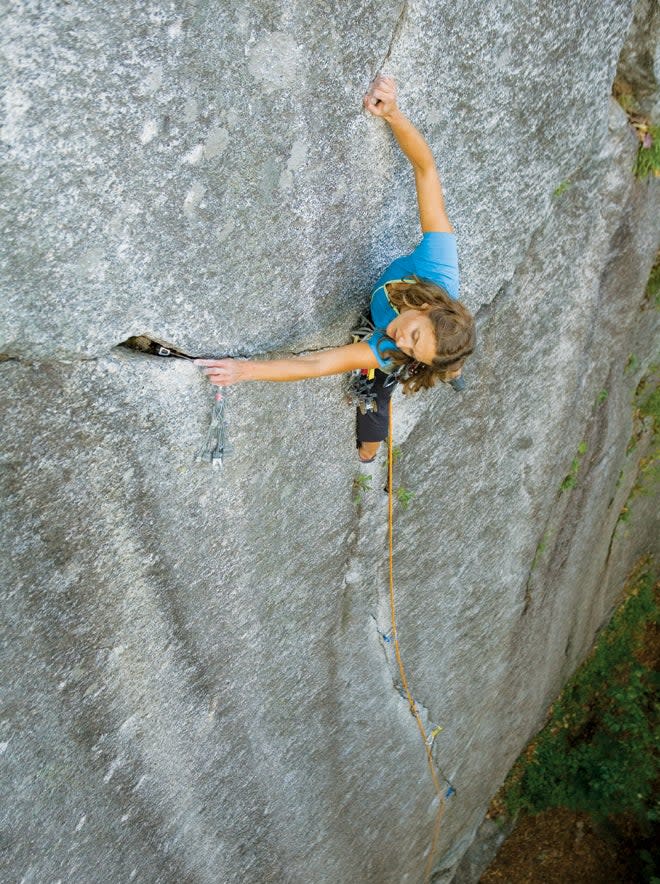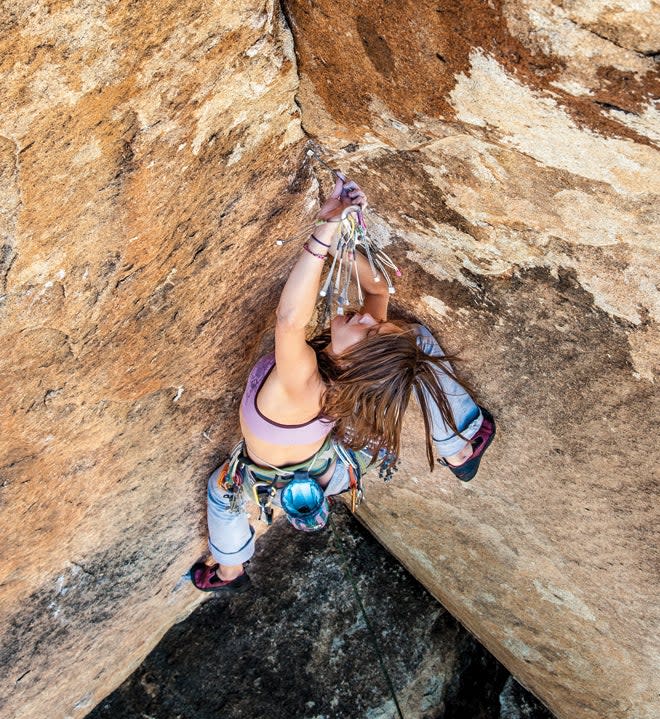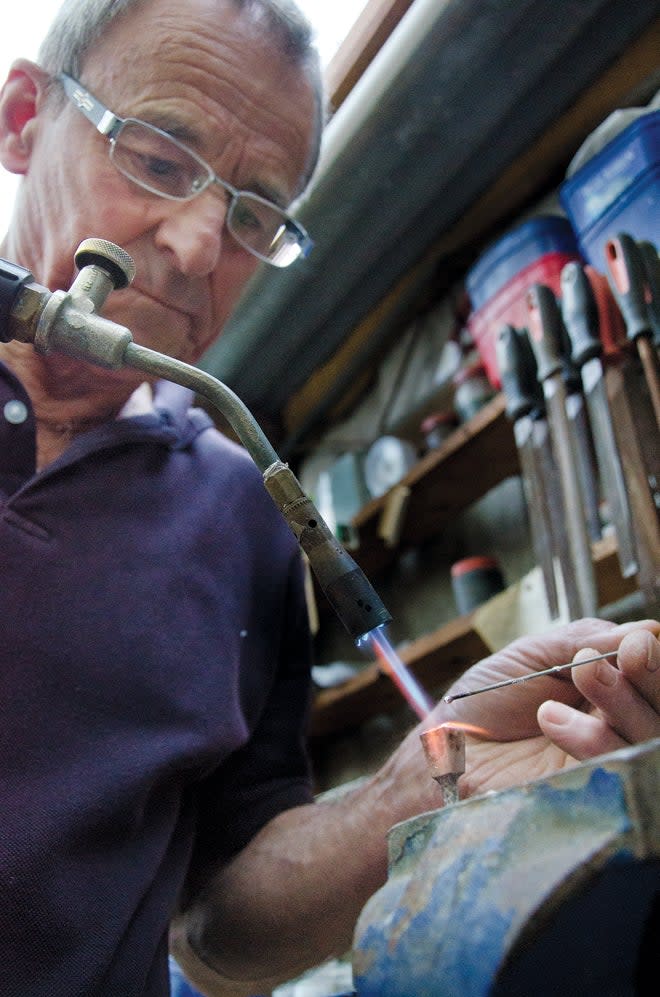Before “the Nut” There Was “the Pebble”… and It Was Sketchy
This article originally appeared on Climbing
This article originally appeared in Climbing in 2013.
Before the nut there was…
Climbing nutcraft evolved in Great Britain about a half century ago, but its roots go back even further. As early as the 1920s, British climbers had carried pebbles in the pockets of their knickers, slotting these stones into wide spots in cracks and tying them off--with scary-looking hemp cord--for pro. True artificial chockstones were just a small conceptual step away, but it took a few decades.
During the 1930s, rock climbing--then much more closely allied with alpinism than it is now--was at an ethical crossroads. In Europe, some climbers, mostly German, were using a new secret weapon--pitons-- to ascend previously unclimbable terrain. Pitons weren't unknown before this time, but these Germans were now using them in great quantity and developing full-on aid techniques--like pendulums (for swinging past featureless terrain) and sustained climbing in etriers (short clip-on ladders)--to ascend spectacular new routes on vertical and overhanging walls in the limestone Alps of Italy, Germany, and Austria. In contrast to these developments, purist free-climbers--some Germans and Austrians but especially the British-- began to eschew the use of pitons completely and set about pushing harder and harder routes without them. These efforts often resulted in ascents that were essentially free-solos, but many climbers made good use of natural protection opportunities such as slings around horns and small natural chockstones wedged in cracks. The harder these piton-free climbs became, the greater the reliance on chockstones. Pebbles aren't the only objects that wedge in cracks, as climbers soon demonstrated.
The origin of the nut
Legend identifies the actual birthplace of the "nut" as the railroad along the approach to Clogwyn Du'r Arddu, one of the iconic crags of Welsh free climbing. Sometime in the 1950s, British climbers discovered that the steel machine nuts found scattered along the tracks worked much better for climbing protection than pebbles. The hexagonal facets allowed more consistent wedging action, and the center holes allowed the nuts to be pre-slung with cord. Soon climbers, with meticulous attention to detail, were filing off the threads and making various other modifications to a whole size range of machine nuts, slinging them, and taking them up to the crags for pro--and sometimes falling on them.

Enter commerce & the iron age
According to the Corsican climber and climbing historian Stephan Pennequin, who wrote The Nuts' Story (needlesports.com/NeedleSports/nutsmuseum/nutsstory.htm), we can credit the Sheffield blacksmith John Brailsford with producing the first commercial, made-for-climbing nuts in 1961. These were cones-haped aluminum jobbies called Acorns. Soon, various small "companies" (usually one dude) in England's Peak and Lake districts and in Wales were producing first-generation nuts such as MOACs, Earnshaw Spuds, Peck Crackers, Troll Wedges, and Clog Hexagons, the latter being the earliest known precursor of the famous 1970s American "hex."
In 1966, one of the U.S.' foremost Yosemite pioneers, Royal Robbins, visited England and Wales, and, following local tradition, climbed a bunch of routes "all clean," meaning just nuts, no pitons. Delighted with the new tools, Robbins returned to the U.S. with a big batch of British nuts and a zeal to spread their use. This seemed to many like a crackpot idea, and it took a while to catch on.
Remember that the late 1960s were the "Iron Age" of American climbing, where new-wave hard-steel pitons including knifeblades and RURPs were the key to opening up Yosemite's walls, producing extremely thin and tenuous aid pitches. Yosemite piton-pounders were proudly putting up the world's longest and sheerest rock climbs, with both hard aid and hard free climbing. Comparing themselves to the "Direttissima" school of Europeans, whose heavyhanded use of bolts made anything possible, the Americans felt they were already climbing in impeccable style. Thus, they weren't impressed with the imported British concept of nuts.
One of the Americans' main points of pride was maintaining the difficulty of repeat ascents of the hardest routes. Unlike Europe, where the necessary pitons were generally fixed during a first ascent--making repeats mere clip-ups in some cases--American style dictated that the pitons be removed after the ascent. The climbers claimed to do this out of purity, requiring future ascent parties to do equally desperate piton-bashing. (That's the official story, but since these climbers were Camp 4 dirtbags, it's just as probable that the main motivation was to recover the expensive hardware.) Regardless, this repeated placement and removal of pins soon revealed an ugly side. It trashed many once-beautiful granite cracks, with one poster child being Yosemite's "first 5.11," Serenity Crack (freed in 1967, now pin-scarred down to 5.10d).
Robbins and others loudly advocated a less destructive protection method--nuts. Robbins kicked it off with a few well-publicized all-nut first ascents--notably Nutcracker (5.8) in Yosemite, in 1967, using British nuts. Still, climbers resisted switching from the security of pounded iron to the apparent dicey delicacy of "clean climbing" on slotted nuts. A wave of articles followed: Robbins' "Nuts to You" in the Californiabased climbing magazine Summit; Tom Frost's "Preserving the Cracks" in the 1972 American Alpine Journal; and perhaps most eloquently, Doug Robinson's "The Whole Natural Art of Protection" in one of clean climbing's holy scripts, the 1972 Chouinard Equipment catalog.
The turning point might have been when Robinson, Galen Rowell, and Dennis Hennek made a clean ascent of the Regular Northwest Face of Half Dome in 1973 and published an article in National Geographic. With even the general public now in the know about the schism between "leave no trace" clean climbers and the "destructive" ironmongers, opinion among climbers began to bend. Most were shamed into at least trying nuts--and that was all it took. With a few exceptions where pitons would have been really nice, nuts were quickly found to be superior for free climbing: quite secure when used properly, and way faster and less strenuous to place than hanging off one arm to pound in a piton.

Innovations
Next came the golden age of design developments, resulting in various bizarre nut dinosaurs and some enduring classics. In 1972, we got the Chouinard Hexentrics, an elegant, asymmetrical design that still appears on logos to this day. The shape allowed each hex to be wedged in three different-sized cracks, covering cracks from finger to fist if you had the whole #1 through #11 set. The next year, Chouinard Equipment--Tom Frost and Yvon Chouinard--added Tube Chocks, the first "clean" pro for Yosemite's feared offwidths. And in 1975, the same team produced the now-extinct Crack-n-Up, a double-bladed, anchorshaped hard-steel device for the thinnest cracks. (If you can find a hoarded set of Crack-n-Ups, these are still the best and strongest clean pro in existence for micro-nutsized cracks that pinch down too abruptly to accept a wire, or for any crack less than 3/16 inch.)
Another brilliant designer and engineer with a more utilitarian styling than Chouinard was the Colorado climber Bill Forrest, known for being the first to solo Longs Peak's Diamond and climb the Black Canyon's Painted Wall, among other feats. Forrest Mountaineering had a strong following and many effective nuts, including Titons, a T-shaped nut that featured a cantilever-like wedging action. Old-timers who climbed in the 1970s may remember well the distinctive clanging of the bigger Titons, so different in tone than the clinking of Hexentrics.
Forrest's most remembered contribution, however, was a nut that didn't quite work for its intended use: Copperheads, an amazingly simple design that was essentially just a piece of cable with one swage forming a loop and an extra swage forming the "nut." These were designed as cost-effective clean-climbing nuts, but they were kidnapped by big-wall climbers to be hammered into flaring seams. These "bashies" helped create Yosemite's most desperate aid pitches.
In 1975, the new thing was brass, specifically "RPs," an Australian creation. Almost all nuts up to this point had been made from aluminum, but a new design from Down Under employed a different alloy, creating a niche and adding to climbers' arsenals. A few Australians, such as the Arapiles climber Chris Peisker, financed American road trips by selling a few dozen sets of Roland Pauligk's RPs, which instantly became the secret weapon for protecting minimalist seams in places like Tahquitz, California; Eldorado Canyon, Colorado; and the Gunks of New York.

RPs' most innovative feature was actually not the brass, but rather its silver-soldered wire attachment. This eliminated the weak link in previous micro-nut designs: the failure point where the cable kinks tightly across the head of the nut. Silver soldering allowed RPs to have a drastically narrower profile that fit in the shallowest slots. To ease the mind, the softer brass bites into the rock, making the tiny placements seem more secure--but also more prone to shear. And shear they did, as climbers attempted (and fell on) ground-up 5.12s. RPs became synonymous with bold, hard trad, opening up climbs such as The Pirate (5.12d) at Suicide Rock and To RP or Not to Be (5.12a X) in Colorado's Eldorado Canyon. Later iterations of such RP-style nuts featured shear-resistant steel heads.
Several funky "camming" nuts appeared in the mid-1970s, including Kirk's Kamms and SMC Camlocks. Only one is still around, Greg Lowe's much-loved Tricam, not marketed until the 1980s but actually first produced in prototype in 1973.
In 1979, another classic was born, the Wild Country Rocks, the first curved wedge nuts. This sexy and effective design locked around bulges in irregular cracks, making a subtle but dramatic difference, and was quickly copied and expanded upon by other companies, artistically culminating in the beautiful, nothing-but-curves Gemstones, produced briefly by a now-extinct company called Faces.
In 1983, Hugh Banner contributed arguably the last major nut design innovation to date when he introduced "HBs," the first offset nuts, tapered both top to bottom and across the face, creating a "flared-seam-friendly" wedge with almost magical holding power.
By the mid-1980s, nuts had been invented, reinvented, popularized, refined, tweaked, tuned, and had found a home on every climber's rack. The sport was growing, standards were soaring, and climber-engineers' design energy had shifted to a more complex solution, spring-loaded cams, which have a story all their own.
For exclusive access to all of our fitness, gear, adventure, and travel stories, plus discounts on trips, events, and gear, sign up for Outside+ today.
